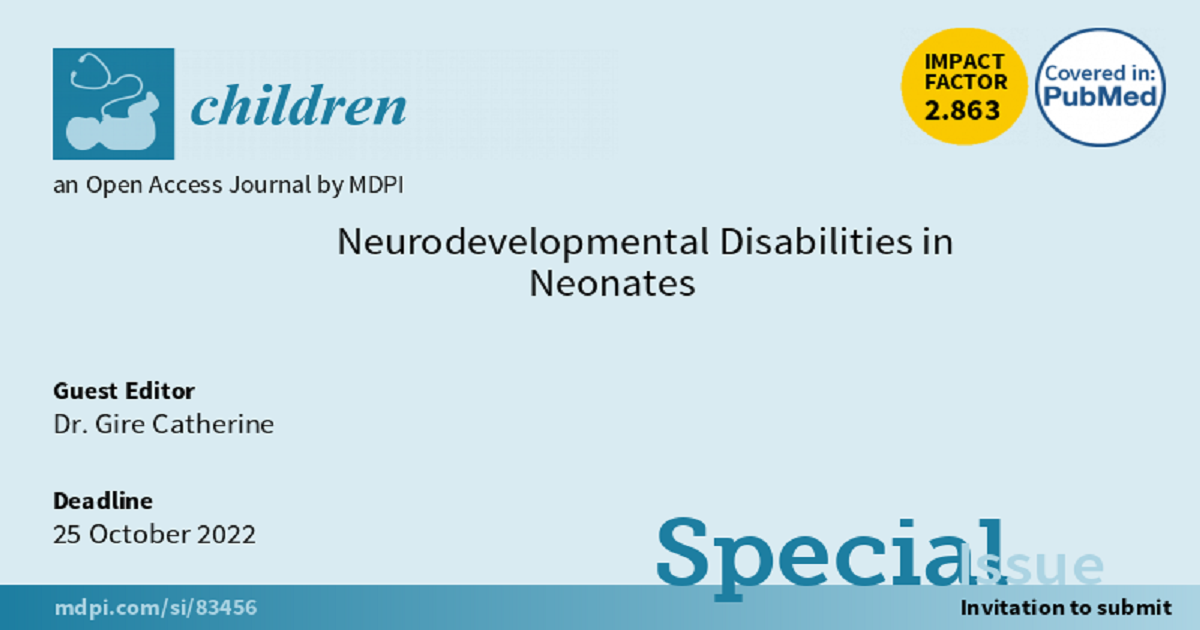Neurodevelopmental Disabilities in Neonates
A special issue of Children (ISSN 2227-9067). This special issue belongs to the section "Pediatric Neurology & Neurodevelopmental Disorders".
Deadline for manuscript submissions: closed (25 October 2022) | Viewed by 20243

Special Issue Editor
Special Issue Information
Dear Colleagues,
Large population-based studies reporting on the fate of prematurely born children have mainly focused on children born extremely preterm and less on children born very or moderately preterm. However, changes in care have been substantial for all groups of preterm infants, and infants born very or moderately preterm represent a large proportion of those with developmental difficulties. Since the advent of neuroprotective therapies and surfactants, neonatal mortality has decreased, and severe disabilities such as mental retardation, autism, and cerebral palsy have stabilized. This is why low-severity dysfunctions are increased, persist, and worsen throughout school years and in young preterm adults with an impact on quality of life.
Premature birth is associated with a significantly increased risk of infantile and adolescent psychopathology, with social adjustment disorders, compared to full-term birth. These social adjustment disorders are correlated with language disorders and/or dysexecutive syndrome and/or behavioral disorders. Thus, neurobehavioral disorders currently dominate the fate of long-term prematurity. Recently, in the French Epipage 2 cohort, the rates of moderate neurodevelopmental impairment are high (approximately 30%) regardless of gestational age. The persistence and worsening of these neurobehavioral disorders in adulthood for those born preterm (e.g., introverted personality, anxiety disorders) leads to withdrawal and social distancing, making it a public health problem.
Comprehensive research over the past three decades has profiled the neurodevelopmental consequences of preterm birth. Nonetheless, relative to our understanding of the motor and cognitive outcomes, robust conclusions regarding the true nature of childhood psychopathology remain a major challenge, spanning from subclinical to clinical presentations. To a reasonable degree, this ambiguity is due to substantial variability in outcome measures, an over-reliance on single informants, limited longitudinal investigations, and a primary focus on broad mental health classifications rather than individual clinical diagnostic criteria.
The aim of this review is to provide a complete characterization of the neurobehavioral phenotype and to highlight the main gaps in knowledge, mainly with regard to the evolution of symptoms, the co-occurrence of disorders, and associations with chronological age and degree of prematurity. Hypotheses which suggest that this neurobehavioral phenotype of prematurity is due to brain hypo-connectivity, thus leading to diffuse structural abnormalities similar to autism spectrum disorders but with reduced severity, will be discussed based on brain imaging of the newborn term-corrected age.
Research on preventive interventions, with more individualized approaches capable of mitigating the long-term effects of a premature birth, as well as the identification of risk factors and resilience, will be described. To alleviate mental health problems and parenting disorders leading to impaired brain development which are linked to premature birth, we will talk about the development of “family-centered care” devices in neonatal care and the concept of parental resources with their participation in various projects in partnership with professionals in the field.
To finish we will develop hypotheses on the clinical phenotype of children having presented an encephalopathy anoxo-ischemic to the hypothermia treatment area.
Dr. Gire Catherine
Guest Editor
Manuscript Submission Information
Manuscripts should be submitted online at www.mdpi.com by registering and logging in to this website. Once you are registered, click here to go to the submission form. Manuscripts can be submitted until the deadline. All submissions that pass pre-check are peer-reviewed. Accepted papers will be published continuously in the journal (as soon as accepted) and will be listed together on the special issue website. Research articles, review articles as well as short communications are invited. For planned papers, a title and short abstract (about 250 words) can be sent to the Editorial Office for assessment.
Submitted manuscripts should not have been published previously, nor be under consideration for publication elsewhere (except conference proceedings papers). All manuscripts are thoroughly refereed through a single-blind peer-review process. A guide for authors and other relevant information for submission of manuscripts is available on the Instructions for Authors page. Children is an international peer-reviewed open access monthly journal published by MDPI.
Please visit the Instructions for Authors page before submitting a manuscript. The Article Processing Charge (APC) for publication in this open access journal is 2400 CHF (Swiss Francs). Submitted papers should be well formatted and use good English. Authors may use MDPI's English editing service prior to publication or during author revisions.
Keywords
- preterm long term outcome
- neurobehavioural phenotype
- dysexecutive syndrome
- neonatal brain imaging
- development care
- family-centered care
Benefits of Publishing in a Special Issue
- Ease of navigation: Grouping papers by topic helps scholars navigate broad scope journals more efficiently.
- Greater discoverability: Special Issues support the reach and impact of scientific research. Articles in Special Issues are more discoverable and cited more frequently.
- Expansion of research network: Special Issues facilitate connections among authors, fostering scientific collaborations.
- External promotion: Articles in Special Issues are often promoted through the journal's social media, increasing their visibility.
- Reprint: MDPI Books provides the opportunity to republish successful Special Issues in book format, both online and in print.
Further information on MDPI's Special Issue policies can be found here.






